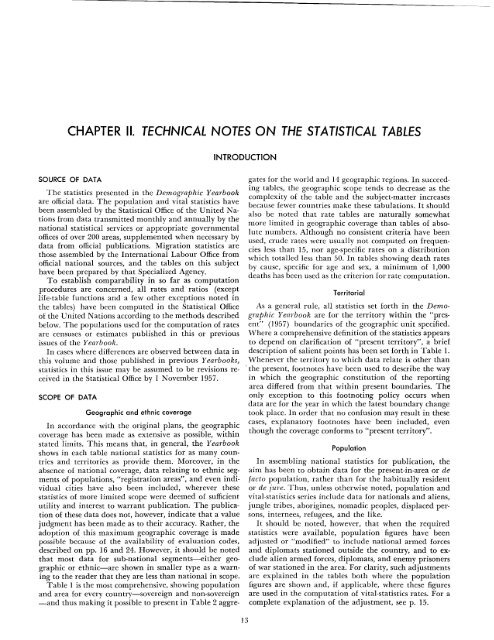1957 - United Nations Statistics Division
1957 - United Nations Statistics Division
1957 - United Nations Statistics Division
Create successful ePaper yourself
Turn your PDF publications into a flip-book with our unique Google optimized e-Paper software.
CHAPTER II. TECHNICAL NOTES ON THE STATISTICAL TABLES<br />
SOURCE OF DATA<br />
The statistics presented in the Demographic Yearbook<br />
are official data. The population and vital statistics have<br />
been assembled by the Statistical Office of the <strong>United</strong> <strong>Nations</strong><br />
from data transmitted monthly and annually by the<br />
national statistical services or appropriate governmental<br />
offices of over 200 areas, supplemented when necessary by<br />
data from official publications. Migration statistics are<br />
those assembled by the International Labour Office from<br />
official national sources, and the tables on this subject<br />
have been prepared by that Specialized Agency.<br />
To establish comparability in so far as computation<br />
procedures are concerned, all rates and ratios (except<br />
life-table functions and a few other exceptions noted in<br />
the tables) have been computed in the Statistical Office<br />
of the <strong>United</strong> <strong>Nations</strong> according to the methods described<br />
below. The populations used for the computation of rates<br />
are censuses or estimates published in this or previous<br />
issues of the Yearbook.<br />
In cases where differences are observed between data in<br />
this volume and those published in previous Yearbooks,<br />
statistics in this issue may be assumed to be revisions received<br />
in the Statistical Office by 1 November <strong>1957</strong>.<br />
SCOPE OF DATA<br />
Geographic and ethnic coverage<br />
In accordance with the original plans, the geographic<br />
coverage has been made as extensive as possible, within<br />
stated limits. This means that, in general, the Yearbook<br />
shows in each table national statistics for as many countries<br />
and territories as provide them. Moreover, in the<br />
absence of national coverage, data relating to ethnic segments<br />
of populations, "registration areas", and even individual<br />
cities have also been included, wherever these<br />
statistics of more limited scope were deemed of sufficient<br />
utility and interest to warrant publication. The publication<br />
of these data does not, however, indicate that a value<br />
judgment has been made as to their accuracy. Rather, the<br />
adoption of this maximum geographic coverage is made<br />
possible because of the availability of evaluation codes,<br />
described on pp. 16 and 24. However, it should be noted<br />
that most data for sub-national segments--either geographic<br />
or ethnic-are shown in smaller type as a warning<br />
to the reader that they are less than national in scope.<br />
Table 1 is the most comprehensive, showing population<br />
and area for every country-sovereign and non-sovereign<br />
-and thus making it possible to present in Table 2 aggre-<br />
INTRODUCTION<br />
gates for the world and 14 geographic regions. In succeeding<br />
tables, the geographic scope tends to decrease as the<br />
complexity of the table and the subject-matter increases<br />
because fewer countries make these tabulations. It should<br />
also be noted that rate tables are naturally somewhat<br />
more limited in geographic coverage than tables of absolute<br />
numbers. Although no consistent criteria have been<br />
used, crude rates were usually not computed on frequencies<br />
less than 15, nor age-specific rates on a distribution<br />
which totalled less than 50. In tables showing death rates<br />
by cause, specific for age and sex, a minimum of 1,000<br />
deaths has been used as the criterion for rate computation.<br />
Territorial<br />
As a general rule, all statistics set forth in the Demographic<br />
Yearbook are for the territory within the "present"<br />
(<strong>1957</strong>) boundaries of the geographic unit specified.<br />
\Vhere a comprehensive definition of the statistics appears<br />
to depend on clarification of "present territory", a brief<br />
description of salient points has been set forth in Table l.<br />
Whenever the territory to which data relate is other than<br />
'the present, footnotes have been used to describe the way<br />
in which the geographic constitution of the reporting<br />
area differed from that within present boundaries. The<br />
only exception to this footnoting policy occurs when<br />
data are for the year in which the latest boundary change<br />
took place. In order that no confusion may result in these<br />
cases, explanatory footnotes have been included, even<br />
though the coverage conforms to "present territory".<br />
13<br />
Population<br />
In assembling national statistics for publication, the<br />
aim has been to obtain data for the present-in-area or de<br />
facto population, rather than for the habitually resident<br />
or de jure. Thus, unless otherwise noted, population and<br />
vital-statistics series include data for nationals and aliens,<br />
jungle tribes, aborigines, nomadic peoples, displaced persons,<br />
internees, refugees, and the like.<br />
It should be noted, however, that when the required<br />
statistics were available, population figures have been<br />
adjusted or "modified" to include national armed forces<br />
and diplomats stationed outside the country, and to exclude<br />
alien armed forces, diplomats, and enemy prisoners<br />
of war stationed in the area. For clarity, such adjustments<br />
are explained in the tables both where the population<br />
figures are shown and, if applicable, where these figures<br />
are used in the computation of vital-statistics rates. For a<br />
complete explanation of the adjustment, see p. 15.
















